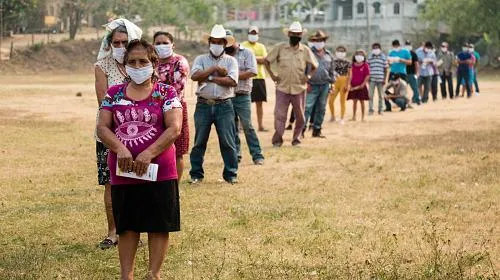Geneva – CARE welcomes the launch of the revised UN COVID-19 Global Humanitarian Response Plan’s (GHRP), including an increased target (to $6.7 billion) and emphasis on Gender Based Violence and Sexual and Reproductive Health Services which are so critically needed at this time. However, nearly two months after the launch of the first GHRP on March 24, minimal resources have reached NGOs, particularly those on the frontlines of existing humanitarian emergencies the world over. CARE calls for an urgent need to “act faster and dig deeper.”
“COVID-19 adds additional strain on an already overburdened humanitarian system” says Sofia Sprechmann Sineiro, CARE International’s Program Director. “While the COVID-19 GHRP is a critical additional lifeline at this time, it’s extremely concerning that UN humanitarian and refugee response plans put in place for existing humanitarian crises collectively remained only 13% funded by end April 2020.”
Needs are escalating fast amid the COVID-19 pandemic. Almost 40% of the near 168 million people in need of humanitarian aid in 2020 reside in only five countries affected by the most severe humanitarian crises and that face high or very high risk of the compounding impacts of COVID-19: Afghanistan, the Democratic Republic of Congo, Somalia, Sudan and Yemen. Yemen for example, remains on the verge of collapse with a devastated health system, an ongoing cholera epidemic, floods and renewed conflict.
“All of these five countries have faced years of protracted conflict which continue today amid a global pandemic that is touching all parts of the world, rich and poor. In DRC alone, COVID-19 adds to an existing disease burden as the country continues its battle to contain both measles and Ebola while conflict is escalating again in Ituri Province” says Sprechmann Sineiro. “While the economic horizon is bleak, we must not be short-sighted; now is not the time to divert existing funds away from ongoing humanitarian crises as the fallout from doing so will be nothing short of catastrophic.”
The gendered dynamics of the COVID-19 pandemic and the devastating impacts on women and girls are also increasingly visible. CARE analysis has shown that COVID-19, when combined in countries experiencing war, poverty and instability creates a perfect storm of risk factors for women, and specifically those forced into confinement with their abusers. Despite this, even before COVID-19, less than 1% of global humanitarian funding was spent on sexual and gender-based violence prevention and response activities.
Amparo Peñaherrera, who works at a shelter for women survivors of GBV that CARE partners with in Sucumbios, Ecuador says: “There is currently so little funding for GBV survivors – it’s unfair, it’s unjust. I hope we learn not to let our privilege cloud our empathy”.
“While it is good to see the increased focus on support for women as part of the COVID-19 response, the UN must accelerate the approval and disbursement of existing funds to NGOs, international and local, from the GHRP – including to women focussed organisations” says Sprechmann Sineiro. “It is critical that funds reach implementers as soon as possible so that the increasingly tight window for preparedness for COVID-19 is not lost.”
“There is no shortcut here” says Sprechmann Sinero. “We urgently need to dig deeper if we are to get the whole world through this pandemic; including with support from civil society organisations, businesses, the private sector and those parts of the economy not feeling the impact of this pandemic so acutely. If we don’t act fast, millions of highly vulnerable men, women and children in high risk countries will be left to battle this pandemic alone.”
###
Media Contact
Ninja Taprogge, COVID-19 Global Media Coordinator
taprogge@care.de
+49 151 701 674 97

